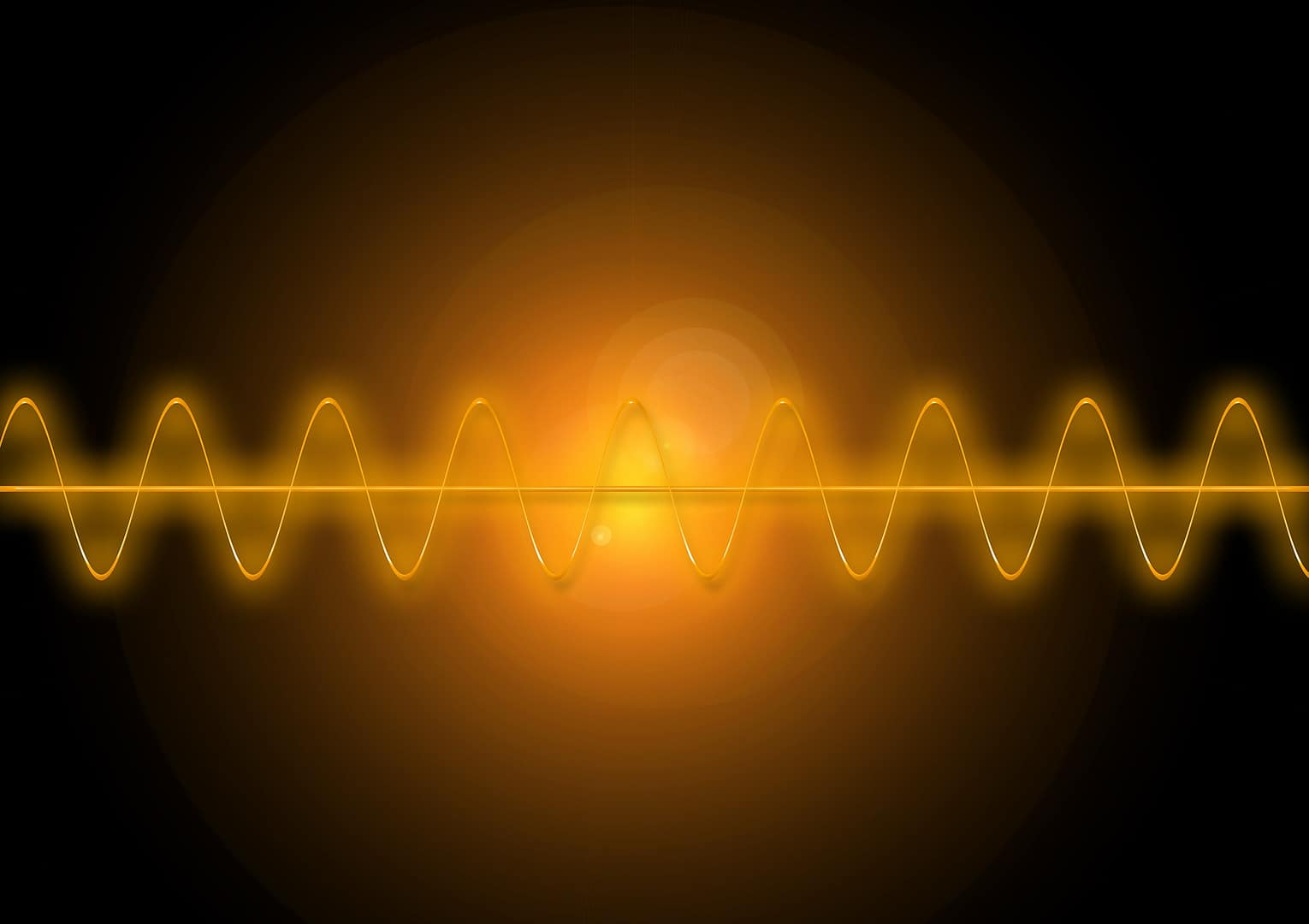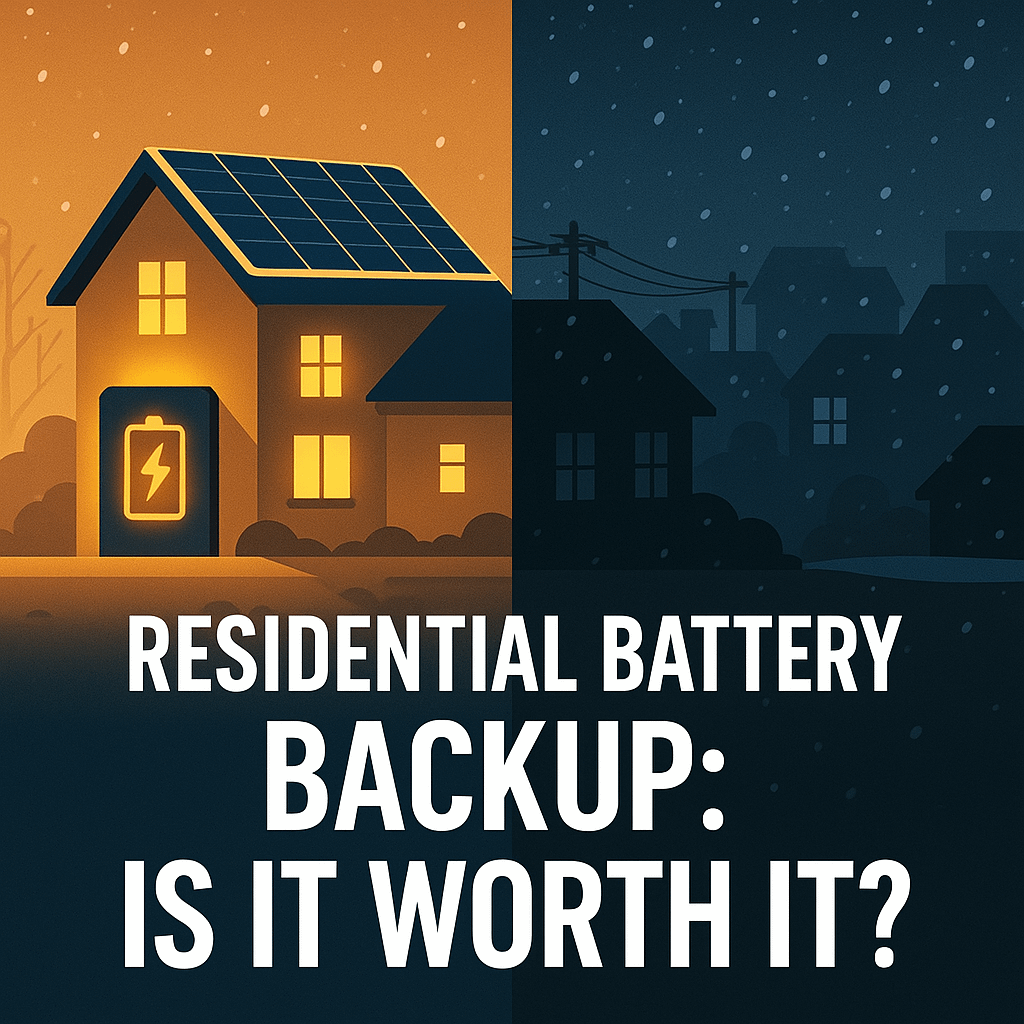Thank you for visiting Evergreen Off-Grid! In other articles we’ve told you how to size your off-grid and grid tied solar photovoltaic (PV) systems. We also taught you to size your battery bank. So, what’s left? Well, there is still much more to consider, but today we’re going to break down another critical component for your PV systems, the inverter.
What is an Inverter and Why do I need One?
To understand what an inverter does we need to understand Direct Current (DC), Alternating Current (AC), and what they do in our PV system.
Direct Current
Both solar and wind power generating systems produce a DC output. Technically, DC means current only flows in one direction. As long we aren’t crossing the zero-voltage boundary, we’re technically outputting DC. However, in our typical use case it’s helpful to think of DC as a constant voltage. If you measure voltage as time passes it will look like a flat line, like the blue line below.

The power generated by your solar panels is DC and so is the power stored and supplied by your battery. If you want to be able to use the power like you do in your home, however, you’ll need to “invert” the DC output to an AC waveform. This is the job of your inverter.
Note: As an affiliate, I earn from qualifying purchases.

2000W 12V Pure Sine Wave Inverter Charger w/ LCD Display – Renogy
$699.99 Original price was: $699.99.$579.99Current price is: $579.99.
Alternating Current

The power you get through the sockets in your home is AC. Think of AC voltage as bouncing smoothly between positive and negative voltage levels as in the blue line below. This periodic wave form is referred to as a sine wave. If you’re in the US, any standard plug that goes into a wall socket is using 120 VAC. A pure (more on this below) 120 VAC output fluctuates between positive 120 volts (VAC+) and negative 120 volts (VAC-).
Pure Sine Wave vs Modified Sine Wave Inverters
Inverters will be available with pure sine wave and modified sine wave output. In general, your higher quality inverters will produce a higher quality, or more pure sine wave. For the most part, a pure sine wave is what you get from the grid and it’s what most of your equipment was designed to run on.
You can save money in the short term by purchasing an inverter with a modified sine wave output, but in most cases, this is inadvisable. Let’s look below to see what the output of a modified sine wave inverter might look like.
Note: As an affiliate, I earn from qualifying purchases.

From inspection, you can see that a modified sine wave output is choppy and not smooth. In some instances, this is no big deal, but for sensitive electronic equipment and other devices it can be a huge deal.
Total Harmonic Distortion (THD)
The term describing how distorted your AC output waveform is from a pure sine wave is total harmonic distortion, or THD. The lower the THD, the smoother and more true your sine wave will be.
Effects of THD
Some equipment relies on the sweeping change of a pure sine wave output and/or it’s precise zero voltage crossing for circuit timing purposes. Powering your equipment with a modified sine wave can cause several issues in some cases.
High THD will cause some equipment to operate out of balance and loudly. It may cause annoying glitches or even cause damage to some equipment.
Inverters that produce modified sine waves also cost you in efficiency. With high THD, less of the power you generate will actually be reaching your load. That means, to account for the loss in efficiency you will need to size your inverter larger, thus eating away at the savings you were going after. The bottom line is, it is strongly recommended that you use a pure sine wave inverter. Sure, a modified sine wave inverter may save you money up front. But what you gain in the near term you lose over time with inefficiency and decreased system performance. An inverter with high THD can shorten the life span and simply cause damage to the equipment you’re trying to power.
Note: As an Amazon Associate I earn from qualifying purchases.
DC Systems
Some of your devices use DC, and it’s great if you can bypass an inverter to power them. Every time you change a waveform from AC to DC or DC to AC, you lose a little bit of energy. When we are generating our own power, the last thing we want to do is waste it. We need every efficiency we can find for our systems.
The types of devices that run on DC are things that you can plug into your USB charger block. You can also find special appliances that run on DC, like refrigerators. If you are planning on designing a DC circuit ensure the voltage level of your devices match the voltage of your system. It may even be beneficial to design your system to support more than one DC voltage level.
What Do We Care About When Sizing Our Inverter?
Just like every other component we’ve discussed so far, inverters come in a variety of sizes and are available for a range of needs. Defining what you need to power, also called your load requirement, or an energy audit, is the bread and butter of defining your PV system size requirements.
To size your battery bank, you were concerned about how much total energy you need and how long you need it for. But when sizing your inverter, you’re interested in how much power you can safely pass through your inverter at one time. If we overload our inverter, we’re either going to shorten its life span or completely fry it. So, rather than evaluate our power needs for an entire day, we’ll just look at the moment in time when our system is running at its maximum load.
Our Example Off-Grid System
In our previous articles (referenced and linked above) we introduced you to an energy audit for our small example bug-out cabin. So, let’s reintroduce you to our little system. It’s perfect for us to chill out, watch tv and eat… and that’s basically it.
For the purposes of those exercises, we were interested in our total energy use. Our table had an entry for every hour of the day and indicated how many Watts each device consumed during each hour. If you’re interested you can head back and take a peek. But for our discussion we don’t need quite so much data.
Let’s take a look at the equipment we’re powering:
- Refrigerator
- TV
- Laptop Computer
- Interior Lighting Circuit
- Exterior Lighting Circuit
- Outlet. Exclusively used for phone charging.
Peak and Continuous Power
When you shop for your inverter, you’re particularly interested in two ratings: peak and continuous power levels. Both are important and both are measured in Watts. The peak power is the highest surge you expect your inverter to “see” for very short durations. These surges are usually due to compressors (like in your fridge) or anything with electric motors. This equipment will have short periods, especially during start up, of very high-power draw. This is the surge or inrush current we use to determine our possible peak demand.
After a short burst of high power, the equipment settles to a more stable, lower power mode. This is our continuous power, which we’ll combine with the typical power draw of every other device that will be powered by our system.
Our Circuit
| Equipment | Continuous (W) | Peak (W) |
| Refrigerator | 50 | 100 |
| TV | 50 | 50 |
| Laptop Computer | 50 | 60 |
| Interior Lighting Circuit | 100 | 100 |
| Exterior Lighting Circuit | 100 | 100 |
| Outlet. | 20 | 20 |
| Total: | 370 | 430 |
Notice, the only piece of equipment in our small set up that differs much between peak and continuous power consumption is your refrigerator. Other types of equipment that will have surge currents are air conditioners and anything with an electric motor. Look for the equipment label plate in these cases to find peak and continuous ratings.
Now we use our table to define our worst-case scenario. Under what conditions will our inverter be put under the most stress? In our case, this means we left all the lights on while we watch tv. Our laptop is plugged in while we’re typing away. Everyone is charging their phones. And we just shut grabbed something from the refrigerator so the compressor has kicked on.
This scenario is the peak power draw for our system. Now we know our continuous power, 370 W, and we know our peak power, 430 W.
Note: As an affiliate I earn from qualifying purchases.
Inverter Chargers

Accounting for Efficiency
So that’s it, right? We just need an inverter rated for a minimum of 370 W continuous, 430 W peak? Well, not quite… There are still some factors we need to consider, like inverter efficiency. Converting your DC to AC does cost you some energy as we discussed above.
Inverter efficiencies range, but average around 90%, so let’s assume that for our example. To account for this let’s divide our values by 0.9 to get our higher rated inverter that will account for efficiency losses.
370 W / 0.9 = 411 W continuous
430 W / 0.9 = 478 W peak

Differing Philosophies
While our example is fairly straight-forward, this is not always the case. If you are sizing an entire home, for example, your circumstances become much more complicated. You may need to put some thought into how all the equipment on your system will be used in practice.
If you have fans and a heater on your system, it probably doesn’t make much sense that they’d be on at the same time. Similarly, it doesn’t make sense to include both pieces of equipment when estimating your peak load.
Needs vs Budget
As with other solar system sizing exercises, inverter sizing comes down to balancing your needs versus your budget. You can save money by being super accurate in your estimates and sizing your inverter to serve exactly what you expect your needs to be. If you do that, expect that your inverter will trip from time to time. Maybe that’s no big deal to you. If this happens, you can probably just figure out what you have plugged in unnecessarily and unplug it. Then you’re off and running again.
On the other hand, constantly riding your inverter to its maximum capacity will surely lower the life span of your inverter. By saving money on a smaller inverter now you may be costing yourself in the long run.
Advantages of Oversizing
If you give your inverter a little breathing room, it’s going to last longer. In addition to your inverter lasting longer you won’t have to constantly worry about it tripping off line. Also, extra capacity on your inverter can potentially allow you to increase the size of your system down the road without having to buy a new inverter.
Safety Factor
A common method of protecting your expensive inverter investment is to apply a safety factor after determining your peak and continuous power requirements. PV system designers will determine their maximum anticipated power draw and multiply that value by, typically, 20 to 40%.
Applying a safety factor is good practice in general when sizing your PV system. If you go overboard you will spend more than you need to and perhaps “spill” PV, or generate more than you can use or store. This is the balancing act that defines PV system design.
We think 25% is a sufficient safety factor so let’s apply that to our example:
411 W * 1.25 = 513 W continuous
480 W * 1.25 = 598 W peak
Final Answer
At this point a little fudging is acceptable. You definitely won’t find an inverter rated at 513/598. But that doesn’t matter, your calculation wasn’t that precise anyways. It’s reasonable to start your inverter search for something rated around 500 continuous and 600 peak, or a 500/600 Watt inverter.
Inverter Applications
You can find small inverters that plug into the cigar lighter receptacle in your car. At about 300 Watts these little inverters will power some small DC loads like a laptop and some cell phones.
As you increase to 500 to 1,000 W inverters you can start powering things like TVs and medium sized refrigerators.
Between 1,000 and 5,000 W you will gradually have the ability to add more energy hungry loads like microwaves and power tools. You will be closer to the upper end of this range once you begin introducing thermal loads like heating and air conditioning.
You may need an inverter capable of handling 5,000+ W to cover your needs. These are available. You can get inverters capable of supporting heavy power industrial applications, if needed.
Click here for an article that will go into more details on what can be powered by various sized inverters.
Note: As an affiliate I earn from qualifying purchases.
Summary
As with sizing your other PV system components, this all boils down to defining your requirements. The more accurately you can do this, the more money you will save. But don’t be afraid to add some spare capacity. A little extra up front will be money saved over the long run.
When sizing your inverter, your primary concern is finding one that can handle the maximum load your system will draw. The maximum load is further broken down into continuous and peak values. Your continuous value is the sum total of the running power of all the equipment you will have connected at the same time. Peak power is the sum total of potential inrush or surge current on your system at any one time.
After you define your system parameters the game is to balance designing a robust system with not buying more system than you need. If you want your questions answered please drop a comment below or email us at info@evergreenoffgrid.com





